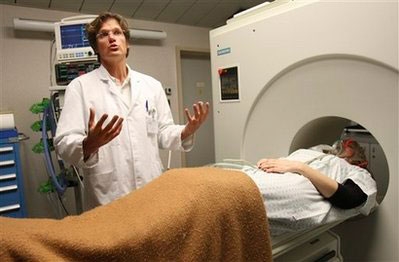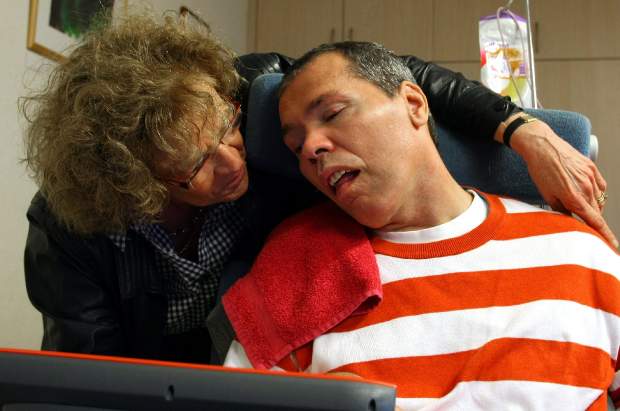
Dr. Steven Laureys with a patient at the University Hospital in Liege, Belgium, Tuesday, Nov. 24, 2009.
Photo: AP Images / Yves Logghe via http://www.christianpost.com/
By Ann Neumann
If thou wert pure and upright; surely now he would awake for thee, and make the habitation of thy righteousness prosperous. Job 8:6 KJV
“I shall never forget the day when they discovered what was truly wrong with me,” Rom Houben, who had been in a coma for 23 years, typed. “It was my second birth. I want to read, talk with my friends via the computer and enjoy my life now that people know I am not dead.” Houben was finally able to communicate these words–via facilitated communication, a method by which a speech therapist helps a minimally conscious person convert thoughts to written language–because Dr. Steven Laureys and a team of Belgian doctors had discovered that some patients with severe brain injury could still be conscious.
“Just imagine,” Houben typed, “You hear, see, feel and think, but no one can see that.” Researchers and the families of those in an array of mentally disabled states rejoiced with the hope that new technology could release their loved ones from the prisons that their bodies had become. “Pro-life” groups across the globe, including the US-based Terri Schiavo Life and Hope Network and the Canadian Euthanasia Prevention Coalition, were particularly enthusiastic about Laurey’s research because they saw it as a chance to sway public perception of the severely brain injured and to prevent those individuals from being removed from “life support,” as Terri Schiavo had been. These groups consider removal of respirators, feeding tubes and defibrillators to be a form of euthanasia. Wrote Alex Schadenberg at the time:
As executive director of the Euthanasia Prevention Coalition I have received many phone calls from friends or family members of people who are in coma. My experience is that medical professionals are too quick to give-up on the person in [a] coma or cognitively disabled. Family members are often pressured into withdrawing medical treatment or pressured into removing food and fluids from the person in a coma, even before they were given a reasonable opportunity for recovery.
But the news of Houben’s “discovery” was not universally accepted; many were skeptical not only of Laurey’s research but of the method Houben’s caretakers were reportedly using to communicate with him. Bioethicist Art Caplan likened facilitated communication to using a Ouiji board. Facilitated communication–and Houben’s ability to “speak” using it–was soundly debunked in February 2010, forcing Laureys, who has been studying “minimally conscious” patients for more than a decade, to recant his support of the communication method.
Said Laureys in 2010, “From the start, I did not prescribe this technique. But it is important not to make judgments. His family and caregivers acted out of love and compassion.” The researcher stood by his own work, which uses PET and fMRI brain scanning machines to detect consciousness in patients previously considered unconscious.
Laureys caused another stir last month with a report in the British medical journal The Lancet on a new study of 126 patients with unresponsive wakefulness syndrome, locked-in syndrome, or in a minimally conscious state. The study, wrote Denise Grady at The New York Times on April 15th, “found that a significant number of people labeled vegetative had received an incorrect diagnosis and actually had some degree of consciousness and the potential to improve.”
Laureys told Grady, “I think these patients are kind of neglected by both medicine and society. Many of them don’t even see a medical doctor or a specialist for years. So I think it’s very important to ask the question, are they unconscious?”
The significance of this finding is great. Reports of those in minimally conscious or vegetative states vary, but Grady notes that in the US “there are 100,000 to 300,000 people thought to be minimally conscious, and an additional 25,000 are vegetative.”
And yet, while I am excited by the kind of research Laureys is conducting–and I’ve been watching him since the case of Rom Houben emerged in 2009–I find a host of reasons to question, if not his conclusions, the potential uses of such research.
The brain is still a vast mystery, a final frontier of uncharted territory in the human body. Diagnoses for minimal consciousness, coma and other such extreme brain injuries are still fairly ill defined, if not in medical literature, at least in diagnosis. And, with the exception of brain death (absolutely no function in the brain) and persistent vegetative state (some function in the brain stem), patients’ mental states can change or be hard to pin down. Too often, various conditions are lumped together despite their vast differences. Laureys’ sample size for the study is also incredibly small. As well, the machines used to conduct the tests of patients’ brains are exorbitantly expensive, putting them out of the reach of many; their use often increases when a hospital purchases them because, well, the cost has to be recouped somehow.
There’s also the question of what exactly “the potential to improve” means in this setting, both medically and to an ever-hopeful family. What level of recovery is possible? What kinds of lives can such patients and their families anticipate. And, what everyone asks under his or her breath: could the expense of these machines and this year-after-year extensive care be better used for patients who can return to fuller lives? The Terri Schiavo Life and Hope Network lists 20 patients who have, since 1997, emerged from “PVS/Locked-In State/Coma,” including Rom Houben. One can’t help but wonder if some of these emergences are attributable to misdiagnosis or varying definitions of what emerge means. Or what quality of life changes these patients can ever expect to experience.
There’s also the question of what exactly “the potential to improve” means in this setting, both medically and to an ever-hopeful family.
Of course, the Life and Hope Network has a clear–and dare I say, persistent–objective, and that is to prevent patients from being removed from “life support” of any form. Bobby Schindler, Terri Schiavo’s brother and executive director of the Network, considers himself a disability rights activist and claims that his sister was “severely mentally disabled” but healthy and capable of living a long life. The Network recently advocated for a brain dead child to be transferred from a hospital that wanted to remove her respirator. Schindler and countless other advocates do not consider brain death (absolutely no brain function) to be death, as the medical community has long agreed that it is. Such groups believe that a person is alive so long as their heart continues to beat, even if made to do so by machines.
The efforts of these groups may be well intentioned, but they tend to confuse the general public about the irreversible nature of such diagnoses. Where there is confusion, there can be great emotional turmoil–and political upheaval. The brain death at the end of last year of a pregnant woman, Marlise Munoz, exposed a Texas law that prevents families from removing “life support” from pregnant patients. Although Marlise Munoz was brain dead, a status that experts say is not covered by the Texas law because brain death is death, the hospital chose to keep Munoz on machines, against her and her husband’s wishes.
The larger politics of Laureys’ work can’t be ignored either. Euthanasia Prevention Coalition and the Terri Schiavo Life and Hope Network are both anti-aid in dying organizations located in countries where aid in dying (or assisted suicide, or euthanasia) is gaining a foothold. Laureys himself is based in Belgium where euthanasia (the accepted term in Europe) has been legal since 2006. In February, and to great global outcry, Belgium legalized euthanasia for minors. Laureys’ work is seen by some as a necessary stay to such legalization; indeed, opponents have worked double-time to hail Laureys’ new study as proof that persons in varying states of brain injury should be kept on machines.
But there’s yet another issue we must consider when reading (and writing) about Laurey’s research, one that is lost on Grady when she writes in the New York Times, “Terri Schiavo, in a vegetative state for 15 years, died in 2005 in Florida after courts allowed the removal of her feeding tube.” The courts determined, according to long-standing jurisprudence, that Schiavo’s feeding tube could be removed not because she was thought to be in an irreversible state or because the courts thought she had no consciousness, but because her husband proved that his wife’s wish would be to have the feeding tube removed. It’s a point that deserves clarity. Regardless of one’s definitions, the foundation of medical ethics is the principle of autonomy: that patients have the right to be fully informed of all available medical options and to select or refuse treatments they do or do not want, even if doing so means certain death.
What then do the results of Laureys’ recent research mean? For the future of brain research, they’re exciting. Perhaps some day this mapping of the brain’s functions will provide us with more accurate diagnoses of such injuries–and in the distant future, some methods for not only communicating with patients, but also providing meaningful treatments for recovery. Those possibilities are still a very long way off, though.
Until then, what does Laureys‘ study mean for patients like Terri Schiavo? Nothing. Her husband satisfied the court that Schiavo would not have wanted to remain on a feeding tube. My fear is that Laureys’ research will be used by activist groups to cause confusion among the public regarding the realities and possibilities for patients like her. Hope, however unrealistic, is powerful. It changes laws, public opinion and hospital practice, as the cases of Terri Schiavo and Marlise Munoz and others have shown. Could Laureys’ hopeful research lead to laws that end informed consent and autonomy for similar families and patients? Could it inhibit doctors’ and hospitals’ decision-making process? In some sense, it already has by providing the unrealistic hope that unconscious patients are still “there”–thus justifying periodic overrides of general medical practice by unnaturally preserving… a far-fetched hope.
When you consider the thousands of patients in the US who are being kept “alive” on machines, the chance that some may be conscious or minimally conscious–with little chance of any meaningful recovery–sustaining their bodies with machines seems barbaric and inhumane. Particularly when we don’t know their explicit wishes. Perhaps some day Laurey’s research will provide us with a way to ask them if they are aware–and if they wish to be.
***
“The Patient Body” is a monthly column about the intersection of religion and medicine. Prior columns can be read here:
Your Ethical and Religious Directives
Hospitals and the Pretense of Charity
***
Ann Neumann is a Visiting Scholar at the Center for Religion and Media at New York University and contributing editor at The Revealer and Guernica magazine. Neumann‘s book about a good death, SITTING VIGIL, will be published by Beacon Press in 2015.


